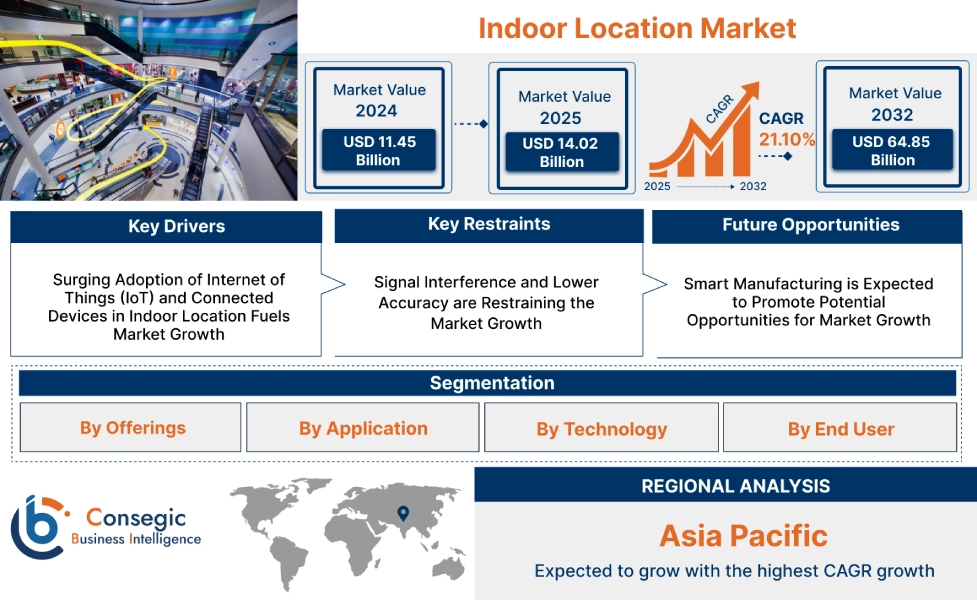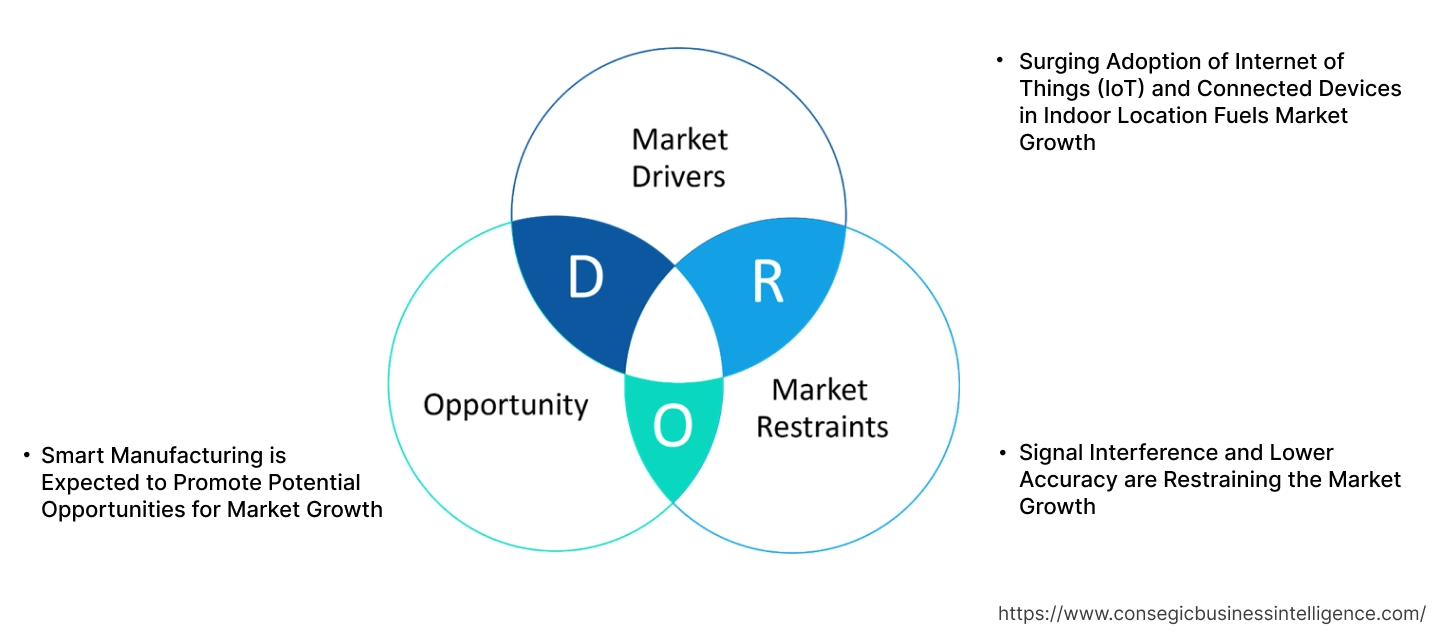Indoor Location Market Size:
Indoor Location Market size is estimated to reach over USD 64.85 Billion by 2032 from a value of USD 11.45 Billion in 2024 and is projected to grow by USD 14.02 Billion in 2025, growing at a CAGR of 21.10% from 2025 to 2032.
Indoor Location Market Scope & Overview:
The indoor location is a solution which utilizes technologies such as BLE, Wi-Fi, and others to determine the location of people or objects within enclosed spaces where GPS signals are unreliable or unavailable. Additionally, the key advantages including enhanced safety and security, increased efficiency and productivity, improved navigation and wayfinding, and valuable data analytics are driving the indoor location market demand. Further, the rising adoption of smartphones is driving the indoor location market growth. Furthermore, the rising need for real-time location tracking in various sectors is driving the indoor location industry.
Indoor Location Market Dynamics - (DRO) :
Key Drivers:
Surging Adoption of Internet of Things (IoT) and Connected Devices in Indoor Location Fuels Market Growth
The proliferation of smartphones and other connected devices is a major factor driving the indoor location market growth. Additionally, the expanding use of IoT in industrial automation and healthcare is propelling the indoor location market demand. Further, the growing popularity of smart home devices, wearable devices, and other consumer IoT products is paving the way for market progress. Furthermore, IoT and connected devices enable precise and real-time positioning within buildings with the help of technologies such as Bluetooth, Wi-Fi, and others.
- For instance, in July 2023, MachineQ extended the capabilities of indoor asset tracking with the help of active asset tags designed to meet customers’ unique asset tracking needs.
Therefore, the rising adoption of IoT and connected devices is driving the demand for systems, in turn, proliferating the growth of the market.
Key Restraints:
Signal Interference and Lower Accuracy are Restraining the Market Growth
The indoor environment creates obstacles such as walls, furniture, and even people, for signals leading to fluctuations in signal strength, hindering the indoor location market expansion. Additionally, the multipath propagation leads to significant errors in distance estimations, and location tracking is restraining the market adoption. Further, the combined effect of interference and multipath propagation creates a barrier to accurately determining the distance between a transmitter and receiver is restraining the market progress.
Therefore, the environmental factors that lead to lower accuracy are hindering the indoor location market expansion.
Future Opportunities :
Smart Manufacturing is Expected to Promote Potential Opportunities for Market Growth
The integration of indoor location technologies with various Industry 4.0 for asset tracking, process optimization, and workplace safety is paving the way for indoor location market opportunities. Further, the rising need for the ability to track assets in real-time within industrial facilities is a major factor driving the market's progress. Furthermore, the sensors are integrated to provide location data to determine various environmental factors such as temperature and material hazards within the facility is propelling the market progress.
- For instance, in April 2025, Pozyx surpasses 100,000 active indoor positioning trackers for use in a wide range of indoor applications, including asset tracking, personnel monitoring, and vehicle management across industrial and logistics environments.
Hence, the rising adoption in the manufacturing industry is anticipated to increase the utilization of systems, in turn promoting prospects for indoor location market opportunities during the forecast period.
Indoor Location Market Segmental Analysis :
By Offerings:
Based on the offerings, the market is segmented into solutions and services.
Trends in the Offerings:
- The trend towards increasing focus on adopting artificial intelligence as an alternative to hardware components, such as Bluetooth, for sophisticated data processing, is driving the solutions segment.
- The trend towards the proliferation of proximity marketing, geofencing, and location analytics is driving the adoption of indoor positioning systems for developing marketing strategies within indoor spaces.
Solutions accounted for the largest revenue share in the year 2024.
- The solutions segment primarily includes connectivity technology, sensors, transmitters, and receivers, among others, for efficient asset tracking and real-time monitoring.
- Additionally, the growth of IoT devices and advancements in positioning technologies are fueling the adoption of the solution segment, which in turn is driving the indoor location market share.
- Further, the rapid digitalization and the need for accurate indoor navigation solutions are fueling the adoption of the solution segment, which in turn is driving the indoor location market share.
- For instance, in January 2023, HERE Technologies partnered with AWS to provide improved performance for indoor/outdoor positioning capabilities to track and manage any number of internet-of-things (IoT) devices.
- Thus, according to the indoor location market analysis, the rapid digitalization and the need for accurate indoor navigation solutions are driving the market progress.
Services segment is anticipated to register the fastest CAGR during the forecast period.
- The services segment comprises maintenance, consulting and other due to the increasing adoption of smart devices and advancements in positioning technologies.
- Additionally, the rising adoption of advanced technologies such as Wi-Fi, Bluetooth, UWB, and others is enabling more accurate and cost-effective indoor positioning solutions.
- Further, the growing need for asset tracking, enhanced customer experience, and improved operational efficiency are driving the indoor location market size.
- Therefore, as per the market analysis, the growing demand for asset tracking, enhanced customer experience, and improved operational efficiency is anticipated to boost the market during the forecast period.
By Technology:
Based on the technology, the market is segmented into Wi-Fi, Bluetooth, RFID, UWB, and others.
Trends in the Technology:
- The integration of machine learning with Wi-Fi technology to handle the complexities of Wi-Fi signal fluctuations and multipath propagation is driving the indoor location market trends.
- The advancements in RFID technology are leading to smaller and more affordable tags, enabling their adoption in a wider range of applications and products is driving the indoor location market trends.
Bluetooth accounted for the largest revenue share of 32.50% in the year 2024.
- BLE technology has evolved to offer improved battery life and reduced power consumption, making it a cost-effective and sustainable solution for indoor positioning.
- Additionally, the demand for real-time location data in various applications, such as logistics, healthcare, retail, and manufacturing, is a major driver for Bluetooth technology.
- Further, the proliferation of IoT devices in various sectors is driving the adoption of Bluetooth technology which is turn is driving the driving the indoor location market size.
- For instance, in June 2021, u-blox launched Bluetooth explorer kits designed for high precision indoor positioning and are designed for widespread adoption for localizing people or assets in indoor environments such as warehouses.
- Thus, according to the indoor location market analysis, the proliferation of IoT devices is driving the market progress.
Wi-Fi is anticipated to register the fastest CAGR during the forecast period.
- The indoor positioning system leverages Wi-Fi infrastructure to determine the location of devices within buildings.
- Additionally, the proliferation of smart devices and the ubiquity of Wi-Fi networks are driving the market adoption.
- Further, Wi-Fi systems are relatively easy to scale and deploy compared to other technologies, making them a cost-effective solution for various businesses.
- Therefore, as per the market analysis, the ability to scale and easily deploy compared to other technologies is anticipated to boost the market during the forecast period.
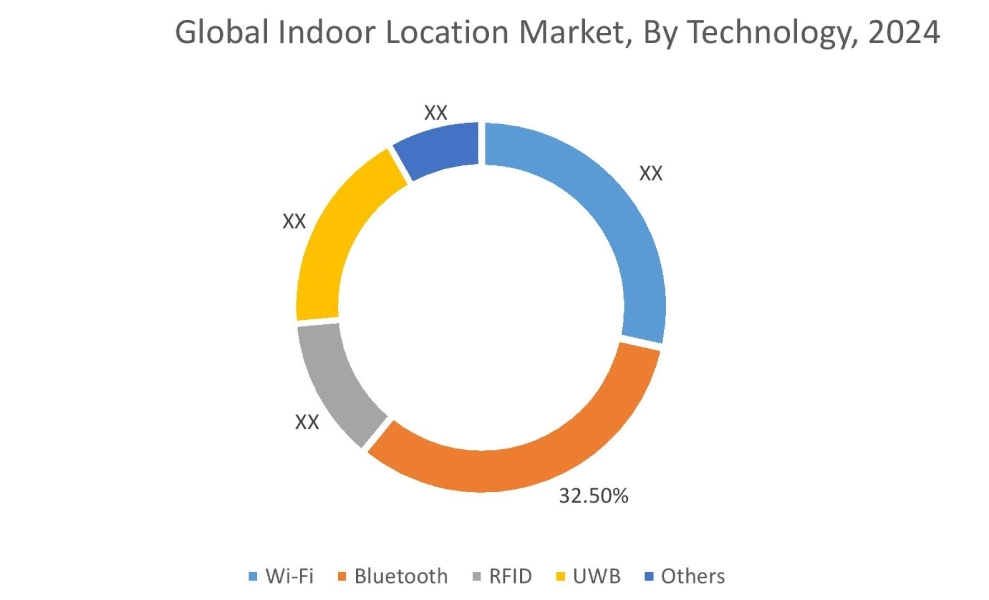
By Application:
Based on the application, the market is segmented into positioning & navigation, occupancy analytics, asset & people tracking, sensor evaluation, and others.
Trends in the Application:
- The trend towards rising adoption by businesses to optimize workflows, improve asset utilization, and reduce operational costs is driving the market adoption for asset & people tracking applications.
- The adoption of indoor navigation systems for optimizing space utilization, enhancing safety, and improving operational efficiency is driving the adoption in occupancy analytics.
Positioning & Navigation accounted for the largest revenue share in the year 2024.
- The positioning & navigation application is majorly utilized in shopping malls, airports, and other is propelling the market adoption.
- Additionally, the smart city initiatives are driving the market adoption for managing large public spaces like airports, shopping malls, and hospitals.
- Further, the increasing demand for location-based services is driving the market adoption in positioning & navigation applications.
- For instance, in December 2024, Ericsson launched 5G indoor advanced positioning for applications in asset tracking, surveying, autonomous driving, drones and others with the help of GPS technology.
- Thus, as per the market analysis, the increasing demand for location-based services is driving the market's progress.
Asset & People Tracking is anticipated to register the fastest CAGR during the forecast period.
- The proliferation of retail & e-commerce is driving the market adoption for asset & people tracking applications.
- Additionally, the key advantages of asset & people tracking include increased efficiency, enhanced safety, reduced cost, improved inventory management and others.
- Further, the increasing focus on tracking medical equipment, monitoring patient flow, and ensuring the timely availability of resources is driving the adoption of asset & people tracking applications.
- Therefore, as per the market analysis, the proliferation of retail & e-commerce is anticipated to boost the market during the forecast period.
By End User:
Based on the end user, the market is segmented into retail & e-commerce, healthcare, manufacturing, government, media & entertainment, military & defence, transportation and logistics, and others.
Trends in the End User:
- The trend towards rising need for improved workflow, especially in emergencies, ensuring the efficient management of the system is driving the market adoption in the healthcare sector.
- The integration of advanced technologies such as AI, computer vision, and AR to improve accuracy and usability with an indoor navigation system is driving the adoption in the military & defence sector.
Retail & E-Commerce accounted for the largest revenue share in the year 2024.
- The increasing adoption of location-based marketing in the retail & e-commerce sector to provide targeted offers and promotions to customers based on their real-time location within the store.
- Additionally, the rising adoption of AI-powered analytics for analyzing customer movement patterns and product interactions within the store is boosting the market progress.
- Further, the retail & e-commerce industry is leveraging augmented reality technology for products, providing additional information, and enhancing the overall shopping experience, creating a more engaging and informative environment.
- Thus, the rising adoption of AI-powered analytics is driving the market progress.
Healthcare is anticipated to register the fastest CAGR during the forecast period.
- The expanding healthcare sector is paving the way for market adoption to integrate with emergency response systems to facilitate quick and efficient evacuation during emergencies.
- Additionally, the rising need for asset tracking, patient monitoring, and emergency response is driving the market adoption in healthcare sector.
- Further, the increasing focus on improving patient care, operational efficiency, and safety is driving the adoption in the healthcare sector.
- Therefore, the rising need for real-time location tracking of patients as well as increasing focus on improving patient care, are anticipated to boost the market during the forecast period.
Regional Analysis:
The regions covered are North America, Europe, Asia Pacific, Middle East and Africa, and Latin America.
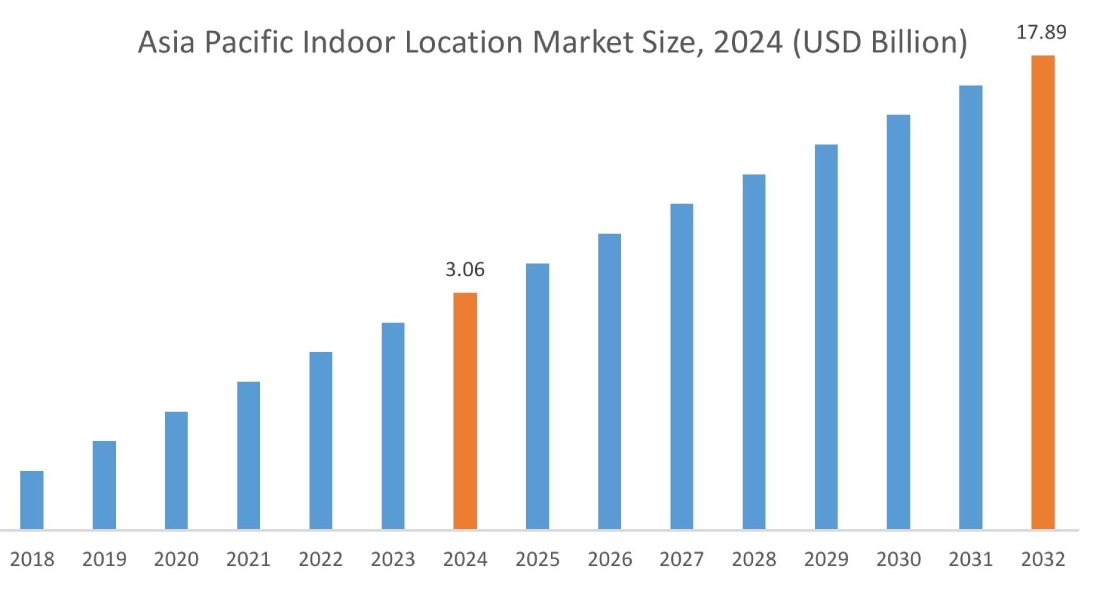
Asia Pacific region was valued at USD 3.06 Billion in 2024. Moreover, it is projected to grow by USD 3.76 Billion in 2025 and reach over USD 17.89 Billion by 2032. Out of this, China accounted for the maximum revenue share of 27.62%. The market progress is mainly driven by the increasing use of smartphones and other connected devices, as well as smart city initiatives. Furthermore, factors including the rise of Industry 4.0 and the Internet of Things (IoT) are projected to drive the market progress in the Asia Pacific region during the forecast period.
- For instance, in May 2024, Mapxus partnered with Kawasaki Heavy Industries for the rebranding of the indoor location information service to Mapxus driven by Kawasaki.
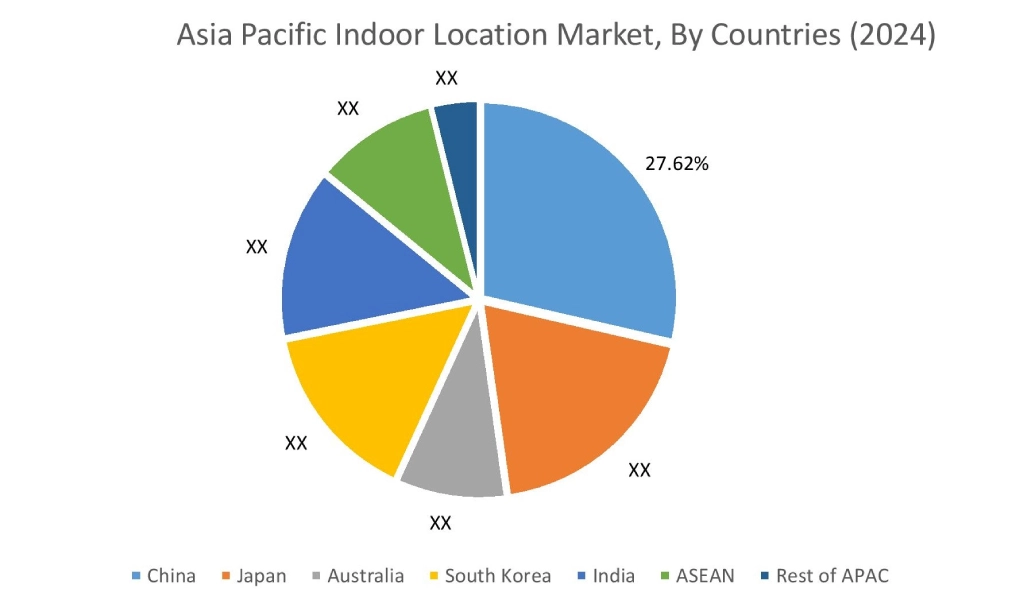
North America is estimated to reach over USD 21.31 Billion by 2032 from a value of USD 3.75 Billion in 2024 and is projected to grow by USD 4.60 Billion in 2025. The North American region's increased need for indoor location-based services across various sectors such as retail, healthcare, and transportation offers lucrative growth prospects for the market. Additionally, the government initiative and investments in public safety and urban security are driving the market progress.
- For instance, in October 2022, Pointr launched AI AI-powered indoor mapping solution called MapScale, which is deployed in 2,000 retail stores which comprise 280 million sq ft of retail space across the U.S.
The regional analysis depicts that the integration of indoor positioning with technologies such as augmented reality (AR) and the Internet of Things (IoT) is driving the market in Europe. Additionally, the key factor driving the market is the rising focus on user privacy and data security, as well as the rise of cloud-based solutions is propelling the market adoption in the Middle East and African region. Further, the expanding retail and e-commerce sector and the healthcare sector are paving the way for the progress of the market in the Latin American region.
Top Key Players and Market Share Insights:
The global indoor location market is highly competitive with major players providing system to the national and international markets. Key players are adopting several strategies in research and development (R&D), product innovation, and end user launches to hold a strong position in the indoor location industry. Key players in the indoor location market include-
Indoor Location Market Report Insights :
| Report Attributes | Report Details |
| Study Timeline | 2019-2032 |
| Market Size in 2032 | USD 64.85 Billion |
| CAGR (2025-2032) | 21.10% |
| By Offerings |
|
| By Application |
|
| By Technology |
|
| By End User |
|
| By Region |
|
| Key Players |
|
| North America | U.S. Canada Mexico |
| Europe | U.K. Germany France Spain Italy Russia Benelux Rest of Europe |
| APAC | China South Korea Japan India Australia ASEAN Rest of Asia-Pacific |
| Middle East and Africa | GCC Turkey South Africa Rest of MEA |
| LATAM | Brazil Argentina Chile Rest of LATAM |
| Report Coverage |
|
Key Questions Answered in the Report
How big is the indoor location market? +
The indoor location market size is estimated to reach over USD 64.85 Billion by 2032 from a value of USD 11.45 Billion in 2024 and is projected to grow by USD 14.02 Billion in 2025, growing at a CAGR of 21.10% from 2025 to 2032.
Which segmentation details are covered in the indoor location report? +
The indoor location report includes specific segmentation details for offerings, technology, application, end user, and regions.
Which is the fastest segment anticipated to impact the market growth? +
In the indoor location market, the healthcare sector is the fastest-growing segment during the forecast period due to the rising need for real-time location tracking of patients as well as increasing focus on improving patient care.
Who are the major players in the indoor location market? +
The key participants in the indoor location market are Cisco (USA), Google (USA), Microsoft (USA), Zebra Technologies (USA), Situm (Spain), Ubisense (UK), HID Global (USA), Apple (USA), Infsoft (Germany), Blueiot (China), and others.
What are the key trends in the indoor location market? +
The indoor location market is being shaped by several key trends including the rising need for improved workflow, especially in emergencies as well as integration of advanced technologies such as AI, computer vision, and AR to improve accuracy and usability with an indoor navigation system are the key trends driving the market.
